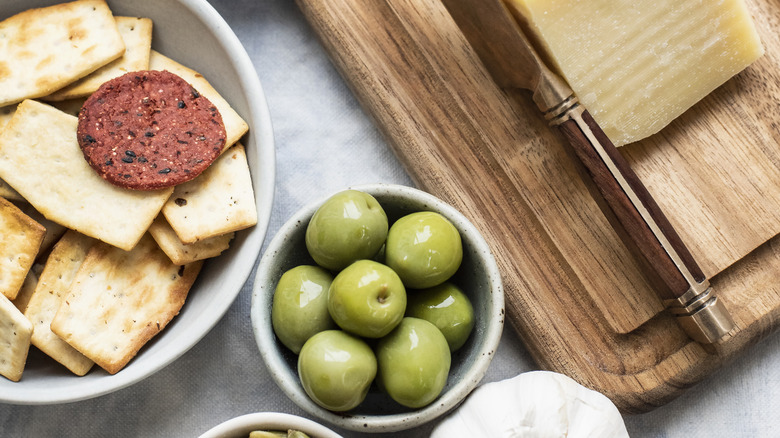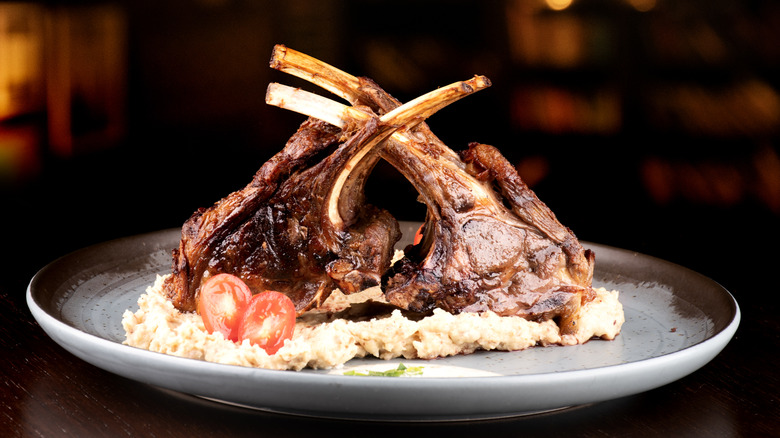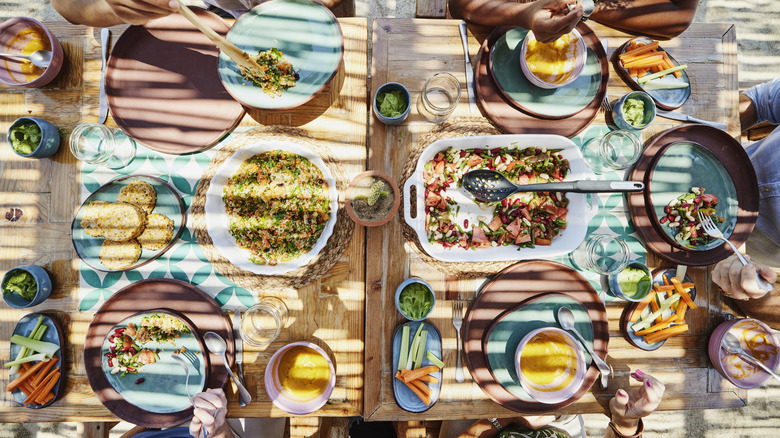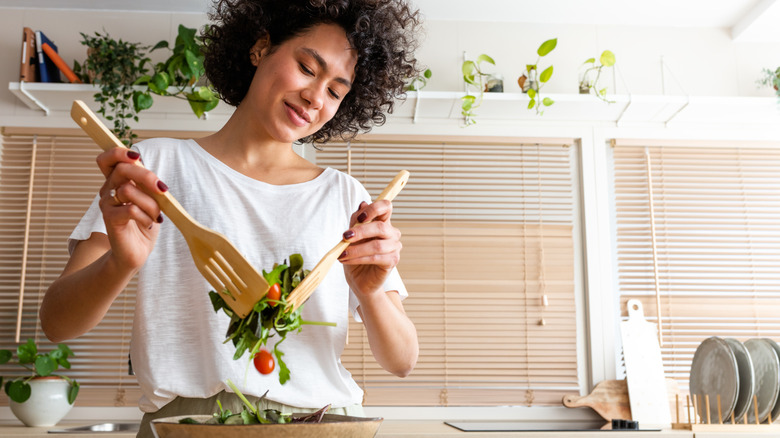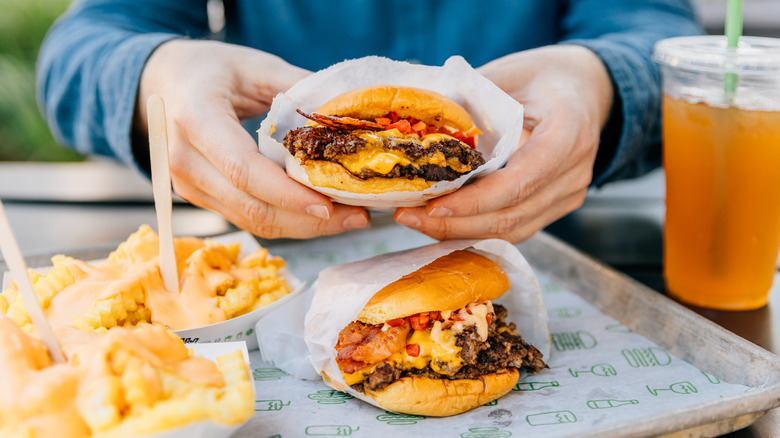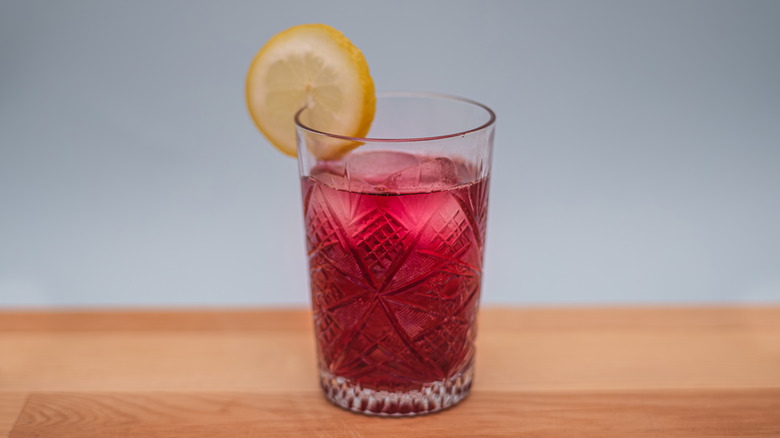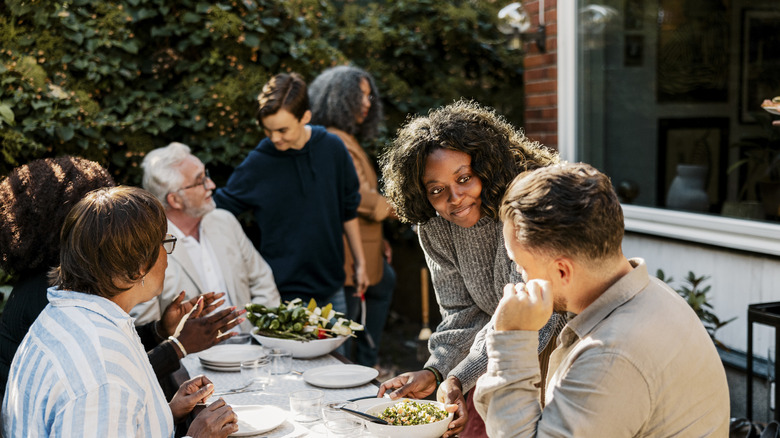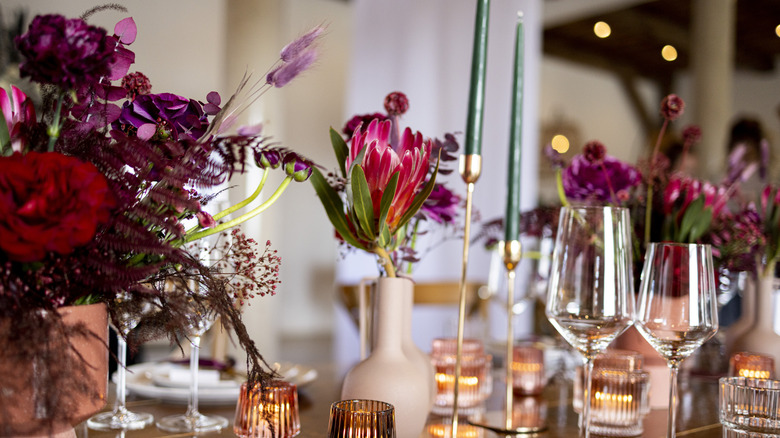16 Of The Biggest Mistakes When Planning A Dinner Party
We may receive a commission on purchases made from links.
Planning a dinner party for the first time can seem like a Herculean effort, but honestly, it never gets much easier. There are so many plates to keep spinning and questions to answer: How many bottles of wine should you buy? Which appetizers will get my guests to the table? What happens if someone breaks one of your special dishes? Should you invite your exuberant goldendoodle? And, for the love of Pete, do you really have to let Susan bring her annoying new boyfriend?
The answers to the following questions are, generally speaking: One per person, yes, get over it, depends on the goldendoodle, and another unfortunate yes. See, dinner parties aren't just about you and your amazing house/cooking — they're about community. That's why we spoke to several dinner party aficionados to relay how to avoid not just food flops and planning pitfalls, but etiquette mishaps, too.
Giving guests too little notice
If you want to impress Ina Garten at your next dinner party, there's one rule you should follow above all else — relax and have fun. The good ol' BFC is just as much about putting people at ease in a beautiful environment as it is about specific dishes. One of the easiest ways to put your guests at ease is to give them plenty of notice, so avoid mistakes centering on time crunches you could just as soon avoid.
"Think of inviting guests like proofing bread dough: Give it time to rise properly," says James Callery of Cross Keys Newbury. "About 2 to 3 weeks' notice is the sweet spot — enough time for people to clear their calendars but not so long they forget they even agreed to come."
As for how to invite them? "The method really depends on the type of event you're hosting," says Brenna Buckley, sales manager at The Benson Hotel & Faculty Club. "For something casual, a group text, email, or direct message usually does the trick. If you're planning a larger or more formal gathering where you need a solid headcount, it's a good idea to send a digital invite with a simple way for people to RSVP."
If you want to go all-out, old-school invitations are absolutely still on the table, especially if "you are going full throttle with candles, flowers, and a three-course dinner," says Jessie-Sierra Ross, cookbook author of "Seasons Around the Table; Effortless Entertaining with Floral Tablescapes & Seasonal Recipes." While paper invites add a touch of nostalgia, she also enjoys a simple Canva template.
Not offering a plus one to singles
Among the biggest dinner party mistakes you can make is to neglect a plus-one option for your single friends. (Or your not-single friends who need an evening away from their spouses. LOL ... but for real.) This is to your benefit as much as to the guests'. "Hosting is about making everyone feel comfortable and welcomed, and that extra guest might be what gets someone to say yes," says Julia Chebotar, Food Network's "Chopped" Champion and the private chef behind Health Chef Julia. "Just make sure to know the headcount so you don't end up with seven extra chairs squeezed between the fridge and the coat rack," James Callery adds.
And, if you're going to offer a plus-one, make sure you do it clearly on the invitation, so no one has to ask. Put this in the details section. You should also make sure to include time, place, RSVP info, and what to bring (if anything), says Marissa Stevens, the blogger and recipe developer behind Pinch and Swirl.
Failing to make a backup plan
Another of the easiest mistakes to make when hosting? Blithely assuming everything will go right and failing to create any contingencies. According to James Callery, this is exactly the wrong approach to take. "The first rule of dinner parties: Assume something will go wrong," he says. "The second rule? Pretend you meant to do it that way." Always have a Plan B, he says. Make sure it's reliable, low-maintenance, and delicious, "like a big pot of risotto or slow-roast pork shoulder." Collapsed soufflé? He advises you to grab those boxed cookies, smile, and say, "I thought we could keep things rustic tonight."
Make sure to take Mother Nature into account, says Alex Sutherland of Vestals Catering. "If the event is meant to be held outside, be sure that there is covering or an indoor option in case of rain." But, Julia Chebotar says, don't stress out about it. Keep an easily plated backup appetizer, an extra bottle of bubbly, and some additional chairs in your back pocket and proceed as planned unless you need them.
Not keeping extra food on hand
Speaking of extra food, you should always have some on hand in case of kitchen mistakes. "I keep it simple: One fallback dish I know by heart and ingredients for a no-cook appetizer like olives, good cheese, and crackers," Marissa Stevens says. "If something burns, doesn't set, or ends up on the floor (don't ask), you have something ready to go." A tried-and-true snack trio such as Divina Organic Castelvetrano Pitted Olives, Cabot Creamery Extra Sharp Cheddar, and Simple Mills Organic Garlic & Herb Seed Crackers will ensure that, even if everything goes sideways, your guests will dine well while you figure out what to do next.
Nobody expects perfection, Jessie-Sierra Ross stresses; they came to see you, not eat your food. (Okay, maybe that too.) If your oven-roasted chicken came out cartoonishly blackened or your strawberry gelée didn't set, she says, just move on. "Pop a bottle of bubbly, have a giggle, and order something delivered! A homecooked dinner is a perk, but a plate of to-go sushi or kung-pao chicken with good friends is amazing too."
Overcommitting to the menu
There's a temptation to go hard when designing your menu, especially if you don't have dinner parties that often. If you're not a professional chef, though, that just leads to mistakes. You're not running a hotel buffet, James Callery says, so remember that "Quality beats quantity every time. Three great dishes are better than seven chaotic ones." Moreover, set aside unnecessary fanciness. "If your starter requires tweezers or a blowtorch, you've gone too far. Cook what feels like you: comforting, delicious, and achievable."
In general, avoid anything too crazy. For instance, save your weird vintage appetizer obsession for a spouse or best friend, and don't serve it to an eclectic group of people, at least if you don't know them that well. You should also take into account whether you will need to do any reheating, then make a plan for it. If you have make-ahead dishes that need to be heated up right before serving, use Bobby Flay's hot broth hack. Simply pour hot broth over or into (by making divots) the food for a thermal flavor boost. But remember, Marissa Stevens says, "If every dish needs last-minute attention, you won't enjoy your own party."
Designing a menu that's not cohesive
Sometimes you make zero mistakes with individual dishes, but when they come together, something feels off. Usually, that's because your menu doesn't gel, which is why it's so important to design a menu that feels cohesive. "A dinner party is like one long conversation," Jessie-Sierra Ross says. "It has a beginning, a middle, and an end. Think of your menu as telling a flavor story!" She advises you research what's in season and roll with it. "One of my favorite summer menus is opening with a fresh caprese salad with crispy eggplant, a truffle butter and creamy mushroom pasta, and wrapping it up with an apricot galette."
Alex Sutherland recommends a similarly simple, relaxed, and seasonal menu. It has the added benefit of helping guests with limited culinary exposure feel more comfortable. "Instead of prioritizing menu items that are unexpected and potentially unapproachable, focus on sourcing fresh, seasonally inspired ingredients that are prepared in high-quality ways."
Forgetting about dietary restrictions
"Nothing kills the vibe like sending your vegan mate home hungry while everyone else tucks into the lamb shank," James Callery says. Always remember to ask about dietary restrictions well ahead of time, so you can plan accordingly. "It's also a good idea to have at least one vegan and one gluten-free option available, just in case a guest has a dietary restriction they didn't mention ahead of time," Brenna Buckley says.
If guests do need accommodating, that's fine. "If only a few guests have specific needs, prepare separate plates or side dishes for them," Buckley continues. "But if multiple guests have similar restrictions, it's often easier to make one meal that accommodates everyone." The easiest way to do this, Alex Sutherland says, is to leave known allergens out of the main meal components. If you eschew gluten, nuts, dairy, and shellfish, you'll make things easier on yourself as well as guests.
Make sure, Callery says, that you ask early and ask kindly. His favorite approach is a bit of signature sass on the invite: "Any allergies, dietary restrictions, or food preferences? Don't be shy — I want everyone leaving full and happy, not hungry and passive-aggressive."
Making too much of a good thing
Wait ... too much of a good thing? Is that even possible with food (says the writer who ate five brownies last night)? Yes, according to Jessie-Sierra Ross. "Maybe you want to impress guests with your favorite baked brie appetizer, and the amazing Wagyu steak with the delicious béarnaise sauce you love so much, and some loaded potatoes with butter, sour cream, and cheese to go on the side," she says. "It sounds amazing, but fatty food on top of fatty food can make people feel too full too quickly." Not to mention, this kind of meal can really tear through your Pepto supplies.
Avoid such mistakes by balancing your menu, she advises. Choose a few lighter dishes, like fruits, veggies, or airy bread, to cut the fat. It's important not to overcommit here. "Pick one 'star' dish, like a flourless chocolate cake, that needs more attention," Ross said, "and then supplement with simpler, but still tasty recipes to complement the dinner."
Making a dish for the first time that night
"Trying a brand-new recipe the night of a party is risky," Marissa Stevens says. There are too many potential mistakes, especially if you're thinking about a genuinely novel dish rather than just a spin on something you've made before. "Look," James Callery says, "the kitchen is not the place for thrill-seeking. Save the high-stakes experiments for bungee jumping."
If you've got your heart set on making something new, Brenna Buckley says, test it out ahead of time. If you have a reliable set of standby dishes you make well but are simply concerned about being fancy, she says, you can elevate your dishes in other ways: "Adding garnishes, using fancy plating, or even sprucing things up with stylish name cards. This way, you can create an upscale vibe without the stress of complex recipes."
Doing it all yourself
Your dinner party isn't just your dinner party. It's everyone's dinner party, and if the host spends the entire time in the kitchen, no one will have as much fun. However, in the desire to put on the perfect party, this is one of the easiest mistakes to make. Resist the urge to lock yourself away in the kitchen, though, and just ask your guests for help.
"Whether it's garnishing a dish, tossing a salad, or arranging something on a platter, guests like to be included," Marissa Stevens says. If you're considering something really time- or labor-intensive, Alex Sutherland advises you to ask yourself, "How will this impact my guests? Does this enhance or detract from my goal for the overall experience of the event?" Maybe that three-course soufflé meal isn't a necessary commitment after all.
Overlooking nondrinkers
One of the biggest mistakes novice dinner partiers make is to forget about the nondrinkers, which isn't limited to those who are sober. Pregnancy, Dry January, and early roll call can all impact whether someone will drink or not, and you may not know a friend isn't drinking until they show up that evening.
Julia Chebotar aims for a 70/30 drinker/nondrinker split, while Marissa Stevens offers two to three alcoholic choices and at least two nonalcoholic choices (not including water). "Rule of thumb," James Callery says, "Assume a third of your guests will want non-alcoholic drinks at some point — whether they're driving, pacing themselves, or just prefer to remember the evening."
"One of the easiest ways to do this," Alex Sutherland says, "is to make a batched cocktail base that is just as delicious without alcohol as it is including it. This can simplify the bar menu, while still serving all of your guests' preferences well." Lemonade and sparkling water are good options, too, while Jessie-Sierra Ross loves to whip up a pitcher of Cherry Lime Rickey. If you're going the simple route with canned beverages, try to level them up a bit. Poppi Sparkling Prebiotic Soda Beverages and Spindrift Sparkling Water both move beyond gussied-up water into the mocktail zone, so guests feel like they're really getting a treat.
Make sure if you're using alcohol in other dishes that you provide a nonalcoholic option for any who might need it. For instance, if you're going to make Julia Child's famously boozy instant coffee sundae, set some plain ice cream aside for nondrinkers.
Planning too few beverages
While you don't need a full bar, make sure to have enough bevvy options on hand so guests can find something to their liking. In general, you can avoid mistakes, Marissa Stevens says, by offering "One signature cocktail, wine, sparkling water, and something zero-proof with flavor." Your signature cocktail doesn't need to be fancy, James Callery adds. If you're short on time, opt for "gin and fancy tonic with a sprig of rosemary that makes you feel like you tried."
Stevens sets up a self-serve station for her guests, including glasses, napkins, bottle openers, ice, and a small tray of garnishes such as citrus slices or herbs. "It keeps things flowing and frees you up to enjoy the party." You can easily stock your home bar with a few staples, such as JoyJolt Layla White Wine Glasses, Disposable Gold Paper Napkins, and a Niubee Acrylic Serving Tray to keep everything organized.
Not planning activities
This is one of the easier mistakes to correct, since dinner party activities needn't be complicated or extravagant. However, especially if not everyone knows one another, it's nice to have a point of focus. "I love having my guests arrange the flowers for the table, or have them plant small little pots of flowers or fresh herbs that can be both decoration and a parting gift," Jessie-Sierra Ross says.
Make sure to keep it casual, Julia Chebotar adds: "Handwritten place cards with fun prompts, a simple toast to kick off the meal, or a playlist guests can add to." If you're going to be outdoors, throw some bocce ball into the mix, Marissa Stevens says, or organize a casual tasting of wine or olive oils inside. And of course, James Callery adds, you can't go wrong with "Two Truths and a Lie."
Forgetting about decorations
Forgetting decorations is one of the most avoidable dinner party mistakes. "For a simple dinner party, I like to have lots of flowers set around my space, as well as on the table," Jessie-Sierra Ross says. "A big and bold single floral centerpiece is gorgeous when paired with candlesticks and long tapers." Remember the three elements of light, color, and texture, she says, and you'll be fine. (But, James Callery cautions, nothing tall enough to block the gossip.)
Feeling creative? Make a butter candle with butter and a food-safe wick. It creates a lovely decorative object into which guests can dip their bread as the candle melts. Although any type of butter will work, Irish butter has a higher fat percentage — see Kerrygold Pure Irish Butter — and may make for a more effective candle.
You can also decorate with simple functional items, like silverware in crocks or rows of champagne glasses, or fanning out your cocktail napkins into a pretty spiral. And, Marissa Stevens says, a few strands of twinkle lights work wonders.
Not making a plan for greeting and parting
Your focus is on the party, but mistakes arise when you fail to plan for the coming and going. "One important thing that is often overlooked is parking," Brenna Buckley says. "Make sure to let your guests know about the parking situation ahead of time." As soon as they appear at the front door, make sure they feel like they've arrived. Have a playlist on and snacks out, and make it clear where the drinks are. "It's a great way to set people at ease and make them feel welcome," Marissa Stevens says.
Time to go? "Provide a parting gift," Jessie-Sierra Ross says. "It's always a lovely touch to have your guests leave your dinner party with more than a plate of leftovers!"
Expecting perfection
Last but not least, stop expecting perfection! Everyone makes mistakes, and you are (probably) not the exception. So throw formality to the winds in favor of fun. "Set the table with what you have," Jessie-Sierra Ross says. "There is a growing trend to set a 'formal table informally' using mismatched vintage china, silverware, and glasses. It's important that we use what we have and elevate it." Flowers, candles, good food, and flowing drinks do just that, without your needing to earn a degree in hospitality.
Also — relax and remember to eat. Seriously. "I've seen too many hosts run around like headless chickens, pouring drinks and plating food, only to sit down at the end looking like they just finished a marathon," James Callery says. "Pour yourself a glass, take a breath, and enjoy your own party."




